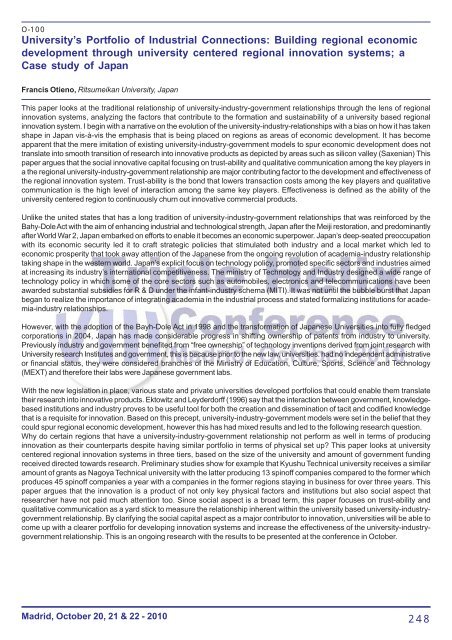TRIPLE HELIX noms.pmd
TRIPLE HELIX noms.pmd
TRIPLE HELIX noms.pmd
You also want an ePaper? Increase the reach of your titles
YUMPU automatically turns print PDFs into web optimized ePapers that Google loves.
O-100University’s Portfolio of Industrial Connections: Building regional economicdevelopment through university centered regional innovation systems; aCase study of JapanFrancis Otieno, Ritsumeikan University, JapanThis paper looks at the traditional relationship of university-industry-government relationships through the lens of regionalinnovation systems, analyzing the factors that contribute to the formation and sustainability of a university based regionalinnovation system. I begin with a narrative on the evolution of the university-industry-relationships with a bias on how it has takenshape in Japan vis-à-vis the emphasis that is being placed on regions as areas of economic development. It has becomeapparent that the mere imitation of existing university-industry-government models to spur economic development does nottranslate into smooth transition of research into innovative products as depicted by areas such as silicon valley (Saxenian) Thispaper argues that the social innovative capital focusing on trust-ability and qualitative communication among the key players ina the regional university-industry-government relationship are major contributing factor to the development and effectiveness ofthe regional innovation system. Trust-ability is the bond that lowers transaction costs among the key players and qualitativecommunication is the high level of interaction among the same key players. Effectiveness is defined as the ability of theuniversity centered region to continuously churn out innovative commercial products.Unlike the united states that has a long tradition of university-industry-government relationships that was reinforced by theBahy-Dole Act with the aim of enhancing industrial and technological strength, Japan after the Meiji restoration, and predominantlyafter World War 2, Japan embarked on efforts to enable it becomes an economic superpower. Japan’s deep-seated preoccupationwith its economic security led it to craft strategic policies that stimulated both industry and a local market which led toeconomic prosperity that took away attention of the Japanese from the ongoing revolution of academia-industry relationshiptaking shape in the western world. Japan’s explicit focus on technology policy, promoted specific sectors and industries aimedat increasing its industry’s international competitiveness. The ministry of Technology and Industry designed a wide range oftechnology policy in which some of the core sectors such as automobiles, electronics and telecommunications have beenawarded substantial subsidies for R & D under the infant-industry schema (MITI). It was not until the bubble burst that Japanbegan to realize the importance of integrating academia in the industrial process and stated formalizing institutions for academia-industryrelationships.However, with the adoption of the Bayh-Dole Act in 1998 and the transformation of Japanese Universities into fully fledgedcorporations in 2004, Japan has made considerable progress in shifting ownership of patents from industry to university.Previously industry and government benefited from “free ownership” of technology inventions derived from joint research withUniversity research Institutes and government, this is because prior to the new law, universities. had no independent administrativeor financial status, they were considered branches of the Ministry of Education, Culture, Sports, Science and Technology(MEXT) and therefore their labs were Japanese government labs.With the new legislation in place, various state and private universities developed portfolios that could enable them translatetheir research into innovative products. Ektowitz and Leyderdorff (1996) say that the interaction between government, knowledgebasedinstitutions and industry proves to be useful tool for both the creation and dissemination of tacit and codified knowledgethat is a requisite for innovation. Based on this precept, university-industry-government models were set in the belief that theycould spur regional economic development, however this has had mixed results and led to the following research question.Why do certain regions that have a university-industry-government relationship not perform as well in terms of producinginnovation as their counterparts despite having similar portfolio in terms of physical set up? This paper looks at universitycentered regional innovation systems in three tiers, based on the size of the university and amount of government fundingreceived directed towards research. Preliminary studies show for example that Kyushu Technical university receives a similaramount of grants as Nagoya Technical university with the latter producing 13 spinoff companies compared to the former whichproduces 45 spinoff companies a year with a companies in the former regions staying in business for over three years. Thispaper argues that the innovation is a product of not only key physical factors and institutions but also social aspect thatresearcher have not paid much attention too. Since social aspect is a broad term, this paper focuses on trust-ability andqualitative communication as a yard stick to measure the relationship inherent within the university based university-industrygovernmentrelationship. By clarifying the social capital aspect as a major contributor to innovation, universities will be able tocome up with a clearer portfolio for developing innovation systems and increase the effectiveness of the university-industrygovernmentrelationship. This is an ongoing research with the results to be presented at the conference in October.Madrid, October 20, 21 & 22 - 2010248










